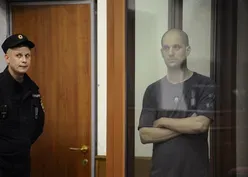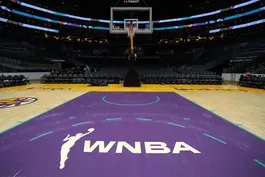
Tornado chasers, meteorologists working for better forecasts
Clip: 7/19/2024 | 6m 50sVideo has Closed Captions
How storm chasers and meteorologists are working together to improve tornado forecasts
Millions of moviegoers are expected to see "Twisters" this weekend, a sequel to the 1996 blockbuster. It's a summer escapist thriller that you might say goes well beyond the science and true boundaries of tornado prediction. Miles O'Brien spent some time during this busy tornado season with actual chasers and meteorologists to understand the latest research.
Problems with Closed Captions? Closed Captioning Feedback
Problems with Closed Captions? Closed Captioning Feedback
Major corporate funding for the PBS News Hour is provided by BDO, BNSF, Consumer Cellular, American Cruise Lines, and Raymond James. Funding for the PBS NewsHour Weekend is provided by...

Tornado chasers, meteorologists working for better forecasts
Clip: 7/19/2024 | 6m 50sVideo has Closed Captions
Millions of moviegoers are expected to see "Twisters" this weekend, a sequel to the 1996 blockbuster. It's a summer escapist thriller that you might say goes well beyond the science and true boundaries of tornado prediction. Miles O'Brien spent some time during this busy tornado season with actual chasers and meteorologists to understand the latest research.
Problems with Closed Captions? Closed Captioning Feedback
How to Watch PBS News Hour
PBS News Hour is available to stream on pbs.org and the free PBS App, available on iPhone, Apple TV, Android TV, Android smartphones, Amazon Fire TV, Amazon Fire Tablet, Roku, Samsung Smart TV, and Vizio.
Providing Support for PBS.org
Learn Moreabout PBS online sponsorshipGEOFF BENNETT: Millions of moviegoers are expected to go see "Twisters" this weekend.
It's a sequel to the 1996 blockbuster.
It's a summer escapist thriller that you might say goes well beyond the science and the true boundaries of tornado prediction.
But Miles O'Brien spent some time during this busy tornado season with actual tornado chasers and meteorologists to understand the latest research.
Here's his report, part of a documentary done with the weather app MyRadar.
MILES O'BRIEN: How do you know where to go?
Jordan Hall is a man on a mission.
Ripe for tornadoes, is that the idea?
JORDAN HALL, MyRadar Storm Chaser: Yes.
So I look at forecast models, HRRR, in particular.
And then I will look at surface models as well.
My goal is to shoot close-range, insane video, and sell it to the news networks.
MILES O'BRIEN: With great success.
He makes a living chasing tornadoes.
JORDAN HALL: You're good, you're good.
MAN: Get in the car, bro.
We got to go.
JORDAN HALL: We're good.
We're good.
MAN: We're not good.
Let's go.
JORDAN HALL: Stay still.
Stay still.
We're fine.
I hear the roar.
MILES O'BRIEN: I sat in his well-equipped SUV and watched highlights of this epic storm-chasing season.
JORDAN HALL: This year has been absolutely bonkers since middle of April, basically been nonstop.
This was the first -- one of the first few tornadoes I saw in this car.
MILES O'BRIEN: Oh, wow, wow, whoa, whoa, whoa.
MILES O'BRIEN: Transformers going.
You were very close to that, my friend.
JORDAN HALL: And then here in a minute, it's going to pipe out right here.
MILES O'BRIEN: Holy cow.
JORDAN HALL: That's a strong tornado.
That's a violent tornado.
MILES O'BRIEN: Is it less risky than it would seem?
Put it that way.
JORDAN HALL: I would say so.
Getting close to these storms always has its dangers.
But the biggest risk I think we all face out there is just driving the countless miles that we do and being on the road so much.
MILES O'BRIEN: The 2024 tornado season has been historic.
About a hundred twisters have touched down in Oklahoma alone, leaving death, destruction and wrecked communities in their wake.
Right now, the Weather Service can provide about 15 minutes' warning of a tornado.
But the explosion of cloud-based computing power and machine learning are enabling big improvements in forecasting.
The cloud is helping researchers understand the clouds.
Is that really changing your business in a fundamental way?
PAM HEINSELMAN, Director, Forecast Research and Development Division, National Oceanic And Atmospheric Administration's: It's changing it in a really good way.
MILES O'BRIEN: Meteorologist Pam Heinselman is the director of the Forecast Research and Development Division at the National Oceanic and Atmospheric Administration's National Severe Storms Laboratory in Norman, Oklahoma.
She and her team are leveraging that compute power to create what they call a Warn-on forecast.
The goal is to improve the lead time and reliability of warnings for severe thunderstorms, tornadoes, and other hazardous weather events.
They're running an ensemble of weather models simultaneously.
Each begins with slightly different data, an effort to account for uncertainties.
With all the things you're doing and are -- plan to do, is that going to change appreciably?
PAM HEINSELMAN: I believe with the forecasters using that system could probably produce a warning out to an hour.
MILES O'BRIEN: But they couldn't imagine an accurate forecast that far in advance without some intrepid field work to obtain better storm data.
Among the storm chasers is a fleet of vehicles carrying state-of-the-art sensors and top scientists.
OK, so what are we looking at here?
ERIK RASMUSSEN, NOAA National Severe Storms Laboratory: So these are the mobile Doppler radars.
MILES O'BRIEN: That's where I met veteran research meteorologist Erik Rasmussen, chief of the field-observing forecast support group.
ERIK RASMUSSEN: These two on the outside are really suited best for seeing the whole storm and they're kind of less nimble.
MILES O'BRIEN: Doppler radar can detect precipitation and, by measuring the shifts in frequency, track the speed and direction of wind within storms.
It's hard to think of a more significant breakthrough in severe storm forecasting technology.
And putting Doppler radars on wheels has dramatically improved scientists' understanding of tornadoes.
ERIK RASMUSSEN: We scan back and forth across the storm like this and then lift the dish up a little ways, do it again and over and over, get a -- kind of a three-dimensional picture of the thunderstorm.
MILES O'BRIEN: They also have a vehicle outfitted with a mobile Doppler lidar, which emits pulses of light, instead of radio waves.
It is more precise than radar.
ERIK RASMUSSEN: Somewhere between like three and 10 times more detail.
We like the nimbleness too because now you're working with a full-size pickup truck, instead of a behemoth.
And so this can maneuver and find parking places a whole lot more easily.
MILES O'BRIEN: The goal is to park these vehicles near a tornado as it is touching down, no small feat.
ERIK RASMUSSEN: We have to get close, and so you have to be able to really maneuver.
MILES O'BRIEN: In the early days, researchers didn't have many tools in their toolbox, and so they relied on 16-millimeter film.
The technique is called photogrammetry.
Erik showed me how it is used to determine the wind speed of a tornado.
ERIK RASMUSSEN: Here we have hundreds of pieces of debris that could be tracked.
MILES O'BRIEN: So you could - - would you go through, like, frame by frame and track individual pieces of debris in all directions?
ERIK RASMUSSEN: That's right, yes.
And then you go back, measure those motions of the markings, and then enter the data onto punch cards and do some math and come up with how strong the wind was that was pushing that debris along.
MILES O'BRIEN: Technology like Doppler radar and lidar may have made photogrammetry obsolete, but they have not answered all the questions, including a crucial one: What are the wind speeds right at the surface?
ERIK RASMUSSEN: I'm thinking the wind speeds are probably stronger than we would have guessed, and I'm thinking they're a lot more chaotic.
I suspect it's going to be a lot more interesting than we would have assumed.
MILES O'BRIEN: To solve that mystery, he and his team will have to devise new sensors and techniques.
He's thinking Doppler drones might be the future.
For the PBS "News Hour," I'm Miles O'Brien in Norman, Oklahoma.
Brooks and Capehart on the pressure on Biden to end his bid
Video has Closed Captions
Clip: 7/19/2024 | 10m 10s | Brooks and Capehart on Trump's familiar message and the pressure on Biden to end his bid (10m 10s)
GOP convention ends with 3rd Trump nomination, unified party
Video has Closed Captions
Clip: 7/19/2024 | 5m 14s | GOP convention ends with Trump’s 3rd nomination and a unified party (5m 14s)
How a software update sparked tech disruptions worldwide
Video has Closed Captions
Clip: 7/19/2024 | 8m 2s | How a faulty software update sparked tech disruptions worldwide (8m 2s)
Pressure mounts as more Democrats ask Biden to step aside
Video has Closed Captions
Clip: 7/19/2024 | 4m 55s | Pressure mounts on Biden to step aside as more Democrats ask him to end his campaign (4m 55s)
Russian 'sham trial' is appalling, WSJ publisher says
Video has Closed Captions
Clip: 7/19/2024 | 5m 48s | Russian 'sham trial' and 16-year sentence for Gershkovich is appalling, WSJ publisher says (5m 48s)
WNBA's surge helps league land breakthrough TV contract
Video has Closed Captions
Clip: 7/19/2024 | 5m 46s | WNBA's popularity surge helps league land breakthrough TV contract (5m 46s)
Providing Support for PBS.org
Learn Moreabout PBS online sponsorshipSupport for PBS provided by:
Major corporate funding for the PBS News Hour is provided by BDO, BNSF, Consumer Cellular, American Cruise Lines, and Raymond James. Funding for the PBS NewsHour Weekend is provided by...
















